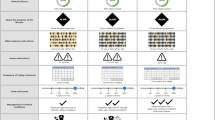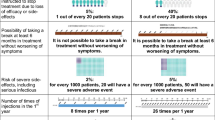Abstract
Background
Either a random-parameters logit (RPL) or latent class (LC) model can be used to model or explain preference heterogeneity in discrete-choice experiment (DCE) data. The former assumes continuous distribution of preferences across the sample, while the latter assumes a discrete distribution. This study compared RPL and LC models to explore preference heterogeneity when analyzing patient preferences for psoriasis treatments.
Methods
Using DCE data collected from respondents with moderate-to-severe plaque psoriasis, we calculated and compared preference weights derived from RPL and LC models. We then compared how RPL and LC explain preference heterogeneity by exploring differences across subgroups defined by observed characteristics (i.e., country, age, gender, marital status, and psoriasis severity).
Results
While RPL and LC models resulted in the same mean preference weights, different preference-heterogeneity patterns emerged from the two approaches. In both models, country of residence and self-reported disease severity could be linked to systematic differences in preferences. The RPL also identified gender and marital status, but not age, as sources of heterogeneity; the LC membership probability model indicated that age was a significant factor, but not gender or marital status.
Conclusions
Using data from a psoriasis patient survey to compare two widely used methods for exploring heterogeneity identified differences in results between stated-preferences: subgroup analysis in the RPL model and inclusion of subgroup characteristics in the class membership probability function of the LC model. Researchers should model data using the most adaptable approach to address the initial study question.




Similar content being viewed by others
Data Availability
The datasets generated and analyzed during the current study are not publicly available due to third-party restrictions. The data may be available from Daniel Saure on reasonable request and with permission of Eli Lilly.
References
Ryan M, Gerard K, Amaya-Amaya M. Using discrete choice experiments to value health and health care. Dordrecht: Springer; 2008.
Marshall D, Bridges JFP, Hauber AB, et al. Conjoint analysis applications in health—how are studies being designed and reported? An update on current practice in the published literature between 2005 and 2008. Patient. 2010;3(4):249–56.
de Bekker-Grob EW, Ryan M, Gerard K. Discrete choice experiments in health economics: a review of the literature. Health Econ. 2010;21(2):145–72.
Clark M, Determann D, Petrou S, Moro D, de Bekker-Grob EW. Discrete choice experiments in health economics: a review of the literature. Pharmacoeconomics. 2014;32:883–902.
Soekhai V, de Bekker-Grob EW, Ellis AR, Vass CM. Discrete choice experiments in health economics: past, present and future. Pharmacoeconomics. 2019;37(2):201–26.
Ashcroft DM, Seston E, Griffiths CE. Trade-offs between the benefits and risks of drug treatment for psoriasis: a discrete choice experiment with U.K. dermatologists. Br J Dermatol. 2006;155:1236–41.
Schaarschmidt ML, Umar N, Schmieder A, et al. Patient preferences for psoriasis treatments: impact of treatment experience. J Eur Acad Dermatol Venereol. 2013;27(2):187–98.
Gonzalez JM, Johnson FR, McAteer H, Posner J, Mughal F. Comparing preferences for outcomes of psoriasis treatments among patients and dermatologists in the U.K.: results from a discrete-choice experiment. Br J Dermatol. 2017;176(3):777–85. https://doi.org/10.1111/bjd.14798.
Fairchild AO, Reed SD, Johnson FR, Anglin G, Wolka AM, Noel RA. What is clearance worth? Patients’ stated risk tolerance for psoriasis treatments. J Dermatol Treat. 2017;28(8):709–15. https://doi.org/10.1080/09546634.2017.1329499.
Alcusky M, Lee S, Lau G, et al. Dermatologist and patient preferences in choosing treatments for moderate to severe psoriasis. Dermatol Ther. 2017;7(4):463–83. https://doi.org/10.1007/s13555-017-0205-2.
Umar N, Yamamoto S, Loerbroks A, Terris D. Elicitation and use of patients’ preferences in the treatment of psoriasis: a systematic review. Acta Derm Venereol. 2012;92:339–409.
Hauber AB, Gonzalez JM, Schenkel B, Lofland JH, Martin S. The value to patients of reducing lesion severity in plaque psoriasis. J Dermatolog Treat. 2011;22:266–75.
Kromer C, Schaarschmidt ML, Schmieder A, Herr R, Goerdt S, Peitsch WK. Patient preferences for treatment of psoriasis with biologicals: a discrete choice experiment. PLoS One. 2015;10(6):e0129120. https://doi.org/10.1371/journal.pone.0129120.
Feldman S, Moeller A, Idemyr S, Gonzalez JM. Relative importance of mode of administration in treatment preferences among plaque psoriasis patients in the United States. J Health Econ Outcomes Res. 2016;4(2):141–57.
Christophers E, Griffiths CE, Gaitanis G, van de Kerkhof P. The unmet treatment need for moderate to severe psoriasis: results of a survey and chart review. J Eur Acad Dermatol Venereol. 2006;20(8):921–5.
Kauf T, Yang JC, Kimball AB, et al. Psoriasis patients’ willingness to accept side-effect risks for improved treatment efficacy. J Dermatol Treat. 2015;26(6):507–13.
Kjaer T, Bech M, Gyrd-Hansen D, Hart-Hansen K. Ordering effect and price sensitivity in discrete choice experiments: need we worry? Health Econ. 2006;15:1217–28.
Schaarschmidt ML, Schmieder A, Umar N, et al. Patient preferences for psoriasis treatments: process characteristics can outweigh outcome attributes. Arch Dermatol. 2011;147:1285–94.
Schmieder A, Schaarschmidt ML, Umar N, et al. Comorbidities significantly impact patients’ preferences for psoriasis treatments. J Am Acad Dermatol. 2012;67:363–72.
Seston EM, Ashcroft DM, Griffiths CE. Balancing the benefits and risks of drug treatment: a stated-preference, discrete choice experiment with patients with psoriasis. Arch Dermatol. 2007;143:1175–9.
McFadden D. Conditional logit analysis of qualitative choice-behaviour. In: Zarembka P, editor. Frontiers in econometrics. New York: Academic Press; 1973. p. 105–42.
Train K. Recreation demand models with taste variation over people. Land Econ. 1998;74(2):230–9.
Spoth R, Ball AD, Klose A, Redmond C. Illustration of a market segmentation technique using family-focused prevention program preference data. Health Educ Res. 1996;11(2):259–67.
Mentzakis E, Ryan M, McNamee P. Using discrete choice experiments to value informal care tasks: exploring preference heterogeneity. Health Econ. 2011;20:930–44. https://doi.org/10.1002/hec.1656.
Zhou M, Thayer MW, Bridges JFP. Using latent class analysis to model preference heterogeneity in health: a systematic review. Pharmacoeconomics. 2018;36(2):175–87.
Sawtooth Software, Inc. CBC user manual. Sequim: Sawtooth Software; 1999.
Thurstone LL. A law of comparative judgment. Psychol Rev. 1927;34:273–86.
Manski C. The structure of random utility models. Theory. 1977;8:229–54.
McFadden D, Train K. Mixed MNL models for discrete response. J Appl Econ (Chichester Engl). 2000;15(5):447–70.
Hauber AB, Gonzalez JM, Groothuis-Oudshoorn CGM, et al. Statistical methods for the analysis of discrete choice experiments: a report of the ISPOR conjoint analysis good research practices task force. Value Health. 2016;19(4):300–15.
Hess S, Rose J. Can scale and coefficient heterogeneity be separated in random coefficients models? Transportation. 2012;39(6):1225–39.
Train K. Discrete choice methods with simulation. Cambridge: Cambridge University Press; 2009.
Hess S, Train K, Polak J. On the use of a modified Latin hypercube sampling (MLHS) method in the estimation of a mixed logit model for vehicle choice. Transp Res Part B Methodol. 2006;40(2):147–67.
Greene WH, Hensher DA. A latent class model for discrete choice analysis: contrasts with mixed logit. Transp Res Part B Methodol. 2003;37(8):681–98.
Hurvich M, Tsai C. Regression and time series model selection in small samples. Biometrika. 1989;76(2):297–307.
McLachlan G, Peel D. Finite mixture models. New York: Wiley; 2000.
Wedel M, Kamakura W. Market segmentation: conceptual and methodological foundations. 2nd ed. Boston: Kluwer Academic Publishers; 2000.
Leroux BG. Consistent estimation of mixing distributions. Ann Stat. 1992;20:1350–60.
Thiene M, Galletto L, Scarpa R, Boatto V. Determinants of WTP for prosecco wine. Brit Food J. 2013;115(2):279–99.
Hynes S, Hanley N, Scarpa R. Effects on welfare measures of alternative means of accounting for preference heterogeneity in recreational demand models. Am J Agric Econ. 2008;90(4):1011–27.
Provencher B, Moore R. A discussion of “using angler characteristics and attitudinal data to identify environmental preference classes”. Environ Res Econ. 2006;34(1):117–24.
Cunningham CE, Kostrzewa L, Rimas H, et al. Modeling organizational justice improvements in a pediatric health service: a discrete-choice conjoint experiment. Patient. 2013;6(1):45–59.
Ho MP, Gonzalez JM, Lerner HP, et al. Incorporating patient-preference evidence into regulatory decision making. Surg Endosc. 2015;29(10):2984–93.
Acknowledgements
The authors gratefully acknowledge Kimberly Moon and Ginger Powell of RTI Health Solutions for overall project management for this study and Kate Lothman of RTI Health Solutions for her help during the development of this manuscript.
Author information
Authors and Affiliations
Contributions
DS, AS, and ER were involved in the study and in defining research questions. MB and BH conducted the statistical analysis and interpreted the results. MB led development of the manuscript, with input from BH. All authors contributed to drafting and revising the manuscript, gave final approval of the version to be published, and agree to be accountable for all aspects of the work.
Corresponding author
Ethics declarations
Conflict of interest
Marco Boeri and Brett Hauber are employees of RTI Health Solutions, which received funding from Eli Lilly and Company to conduct the analyses that are the subject of this manuscript. Daniel Saure and Elisabeth Riedl are employees of Eli Lilly and Company. Alexander Schacht was employee of Eli Lilly at the time of writing the manuscript and is now an employee of UCB Biosciences.
Funding
Financial support for this study was provided by Eli Lilly and Company. The funding agreement ensured the authors’ independence in designing the study, interpreting the data, writing, and publishing the report. The following authors are employed by the sponsor: Daniel Saure and Elisabeth Riedl. Alexander Schacht was an employee of Eli Lilly at the time of writing the manuscript and is now employee of UCB Biosciences. Marco Boeri and Brett Hauber are employees of RTI Health Solutions. The initial work from which the manuscript was generated was presented in 2018 at the Promoting Statistical Insight (PSI) conference in Amsterdam, the Netherlands (Saure D, Boeri M, Thorn K, Schacht A. Make conjoint analyses your standard approach understand how patient preferences vary across different subgroups. 2018 PSI Conference; 5 June 2018; Amsterdam). The presentation included initial results which were then used as starting point for this manuscript.
Ethics and Informed Consent
The research was carried out in compliance with national laws protecting respondents’ personal data and with the Codes of Conduct of the European Society for Opinion and Market Research, the European Pharmaceutical Marketing Research Association, and the British Healthcare Business Intelligence Association. This study was deemed exempt from ethics committee approval in every country where the study was conducted, in line with the codes of conduct of the relevant market research societies. Respondents were recruited among a pool of subjects who had previously agreed to be contacted for market research. At the beginning of the survey, respondents were informed about the general purpose and the objectives of the research, given contact details of a staff member available in case of questions or concerns, and asked to explicitly give consent to participate in the study. The study team was not allowed to contact respondents for purposes other than for answering the survey instrument. In order to protect privacy, providing follow-ups to respondents was also not allowed; however, respondents could contact the study team through the contact received in case of questions of concerns. No clinical data were collected in this study.
Electronic supplementary material
Below is the link to the electronic supplementary material.
Rights and permissions
About this article
Cite this article
Boeri, M., Saure, D., Schacht, A. et al. Modeling Heterogeneity in Patients’ Preferences for Psoriasis Treatments in a Multicountry Study: A Comparison Between Random-Parameters Logit and Latent Class Approaches. PharmacoEconomics 38, 593–606 (2020). https://doi.org/10.1007/s40273-020-00894-7
Published:
Issue Date:
DOI: https://doi.org/10.1007/s40273-020-00894-7




